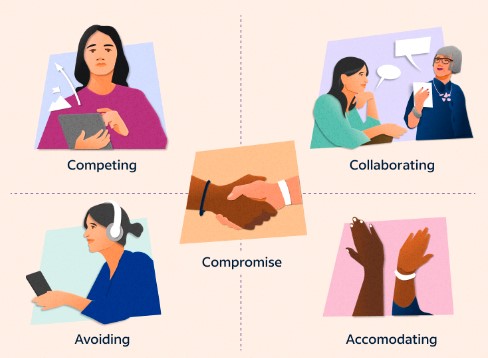Workplace tensions are inevitable in any organization, regardless of size or industry. Whether it’s disagreements between colleagues, conflicting priorities, or misunderstandings, navigating these tensions is essential for maintaining a positive work environment and fostering collaboration. In this comprehensive guide, we’ll explore strategies for effectively managing workplace tensions, resolving conflicts, and promoting a culture of mutual respect and cooperation.

Understanding Workplace Tensions
Before diving into strategies for managing workplace tensions, it’s crucial to understand their underlying causes and manifestations. Workplace tensions can arise from a variety of factors, including:
Differences in Communication Styles
Individuals may have different communication preferences and styles, leading to misunderstandings and conflicts. Some employees may prefer direct and assertive communication, while others may favor a more diplomatic and indirect approach.
Conflicting Priorities and Goals
In a fast-paced work environment, conflicting priorities and goals can create tensions among team members. When individuals have competing objectives or deadlines, it can lead to disagreements over resource allocation and project management.
Personality Clashes
Personalities naturally vary among colleagues, and clashes can occur when individuals have different temperaments, work styles, or values. These differences can lead to friction and misunderstandings, particularly in collaborative settings.
Organizational Changes and Uncertainty
Changes within the organization, such as restructuring, leadership transitions, or policy adjustments, can create uncertainty and anxiety among employees. This uncertainty can manifest as tension and resistance to change.
Strategies for Managing Workplace Tensions
While workplace tensions are inevitable, there are several strategies that individuals and organizations can employ to effectively manage conflicts and promote a harmonious work environment.
Open Communication and Transparency
Encouraging open communication and transparency is essential for addressing workplace tensions constructively. Team members should feel empowered to express their concerns, opinions, and feedback openly and respectfully. By fostering a culture of transparency, organizations can prevent misunderstandings and build trust among colleagues.
Active Listening and Empathy
Active listening is a crucial skill for resolving workplace tensions and promoting understanding among team members. Practicing empathy and putting oneself in the shoes of others can help individuals appreciate different perspectives and find common ground. By actively listening to colleagues’ concerns and validating their experiences, conflicts can be de-escalated, and solutions can be reached collaboratively.
Conflict Resolution Techniques
When conflicts arise, it’s essential to employ effective conflict resolution techniques to address issues promptly and constructively. Techniques such as mediation, negotiation, and compromise can help facilitate dialogue and find mutually acceptable solutions. By focusing on interests rather than positions and seeking win-win outcomes, conflicts can be resolved in a manner that preserves relationships and promotes collaboration.
Establishing Clear Expectations and Boundaries
Clear expectations and boundaries are essential for preventing workplace tensions and promoting accountability among team members. Organizations should establish clear guidelines for communication, decision-making, and conflict resolution processes. By setting expectations upfront and clarifying roles and responsibilities, employees can navigate workplace dynamics more effectively and reduce misunderstandings.
Promoting Diversity and Inclusion
Diversity and inclusion are essential for fostering a positive work environment and minimizing workplace tensions. Organizations should strive to create diverse teams that reflect a variety of backgrounds, perspectives, and experiences. By promoting diversity and inclusion initiatives, such as unconscious bias training and employee resource groups, organizations can create a culture of belonging where all employees feel valued and respected.
Encouraging Collaboration and Team Building
Collaboration and team building activities can help strengthen relationships among colleagues and reduce workplace tensions. Team-building exercises, collaborative projects, and social events provide opportunities for employees to bond and develop trust. By fostering a sense of camaraderie and teamwork, organizations can mitigate conflicts and promote a supportive work culture.
Addressing Specific Scenarios
In addition to these general strategies, it’s essential to address specific scenarios and dynamics that may contribute to workplace tensions.
Managing Conflict Between Colleagues
When tensions arise between colleagues, it’s crucial to address the issue promptly and directly. Encourage individuals to have open and honest conversations to express their concerns and find common ground. If necessary, involve a mediator or HR representative to facilitate dialogue and resolution.
Handling Conflicting Priorities and Goals
When conflicting priorities and goals emerge, it’s essential to prioritize tasks based on organizational objectives and deadlines. Encourage team members to collaborate and communicate effectively to align their efforts and resources. If necessary, involve project managers or team leads to clarify expectations and resolve conflicts.
Dealing with Personality Clashes
Personality clashes can be challenging to navigate, but fostering empathy and understanding can help mitigate tensions. Encourage team members to focus on shared goals and objectives and find ways to leverage each other’s strengths. If conflicts persist, consider offering conflict resolution training or coaching to help individuals develop effective communication and interpersonal skills.
Managing Organizational Changes
During periods of organizational change, such as restructuring or leadership transitions, it’s essential to communicate openly and transparently with employees. Provide regular updates and opportunities for feedback to address concerns and alleviate uncertainty. Encourage employees to adapt to change positively and focus on opportunities for growth and development.
Conclusion
Workplace tensions are a natural part of organizational dynamics, but with the right strategies and approaches, they can be managed effectively. By promoting open communication, active listening, and empathy, organizations can create a culture of trust and collaboration where conflicts are addressed constructively. By addressing specific scenarios and dynamics and fostering a supportive work environment, organizations can navigate workplace tensions successfully and promote a positive and productive workplace culture.

